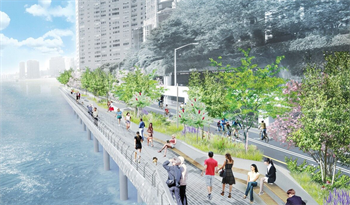
Chicago Department of Transportation
New Riverview Bridge will connect segments of trail along the North Branch of the Chicago River
This week, New York City’s Mayor de Blasio announced that $100 million will be used to advance the Manhattan Waterfront Greenway and “complete the vision of a contiguous 32-mile waterfront pedestrian promenade and bicycling path around the whole of Manhattan.” The new development, set to open in 2022, will be completed by the New York City Economic Development Corporation along the East River. An additional $5 million will be allocated to study the remaining undeveloped segments. Mayor de Blasio called this “the first of many big investments” to fully realize the vision for the Greenway.

New York City Office of the Mayor
New investment will bring a riverfront trail to the East Side of Manhattan.
Likewise, Chicago is making great progress along the Chicago River. Just last year the city completed the construction of the stunning Chicago Riverwalk. Earlier this year, Mayor Emanuel and Paris Mayor Anne Hidalgo co-hosted a forum with 19 mayors from around the globe to discuss reinventing urban waterways for the 21st Century at the Global Waterfronts Forum. Major redevelopment projects—like Riverline and the 62-acre former rail yard bounded by Roosevelt, Clark 16th Street, and the river—will bring new access to riverfront destinations that are connected by a continuous trail. Nine leading architecture firms are examining some of the most vexing challenges between Lake Street and Ping Tom Park in the Chicago Urban River Edges Ideas Lab, led in partnership between the Chicago Department of Planning and Development and MPC. Chicago’s Department of Transportation is working on a new North Branch segment, called Riverview Bridge, which will soar above the river and connect Belmont Avenue to Montrose Avenue.
Yet, despite all of these exciting projects, there is much work to be done and questions remain about funding the design, engineering, and construction. There's also a larger question about the responsiblity of the long-term maintenance and operations of these riverfront spaces and intiatives. The Our Great Rivers vision—released by Mayor Emanuel in partnership with MPC and many others in 2016—calls for a continuous riverfront trail built by 2030.
In order to achieve this vision, we will need a healthy mix of investment – in private real estate; federal, state, and city-led programs; and private donations. Last year, we learned that Ken Griffin was generously donating $12 million to the Chicago Park District to build separate trails for cyclists and pedestrians along the 18-mile Chicago Lakefront Trail. The Chicago River offers a similar opportunity for an amazing quality-of-life amenity for Chicagoans who currently live in riverfront communities without a riverfront. We are only beginning to unlock the potential of our rivers and there’s plenty of space—both physical and financial—to bring the vision of a connected trail to life.